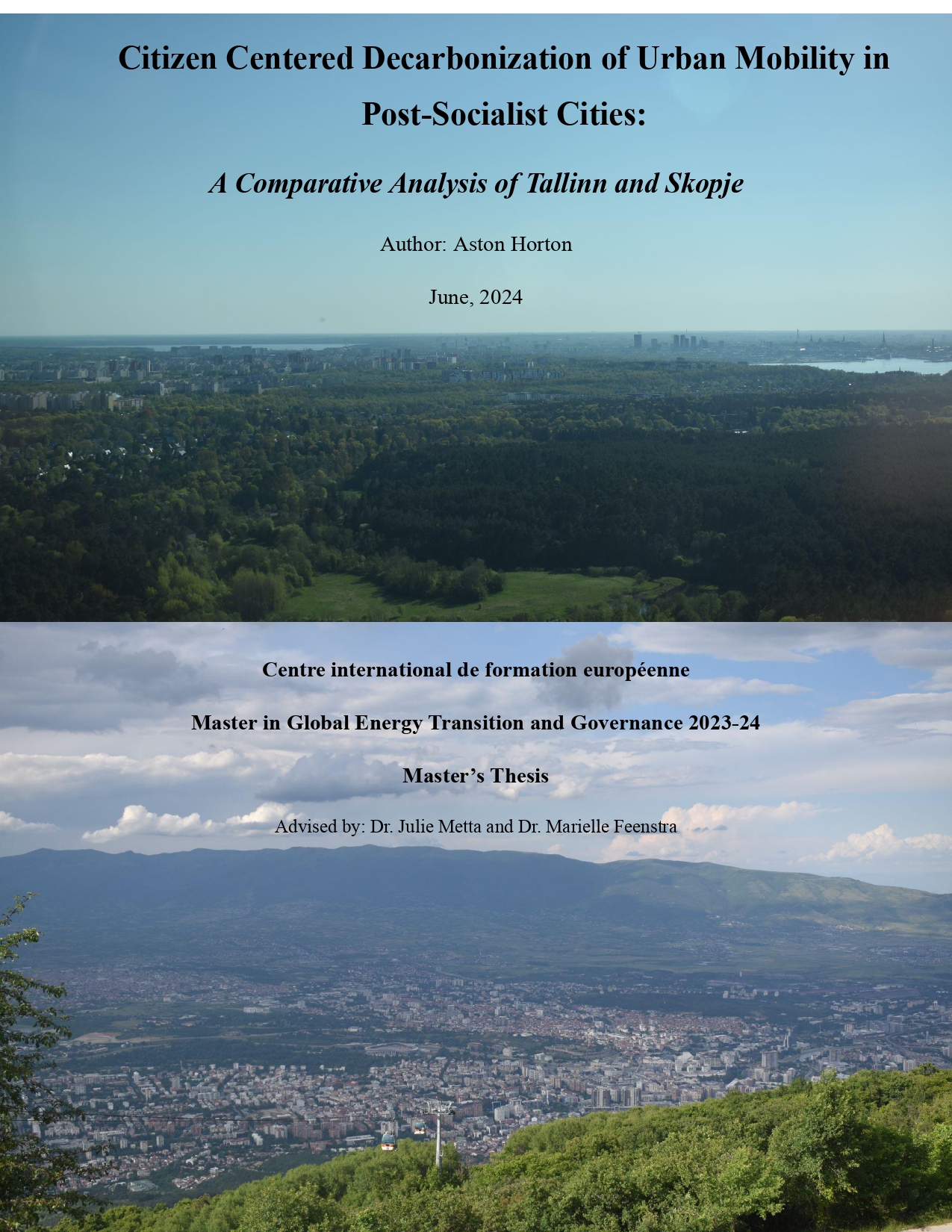Citizen Centered Decarbonization of Urban Mobility in Post-Socialist Cities:
A Comparative Analysis of Tallinn and Skopje
June 2024
Citation
Horton, A. (2024) Citizen Centered Decarbonization of Urban Mobility in Post-Socialist Cities

Citizen Centered Decarbonization of Urban Mobility in Post-Socialist Cities:
A Comparative Analysis of Tallinn and Skopje
| Reference | Masters thesis |
| Date | June 2024 |
| Author | Aston Horton |
| Supervisors | Dr. Julie Metta Dr. Mariëlle Feenstra |
Introduction
Cities lie at the heart of the global energy transition due to outsized population (55% of the world), emissions (60%), and energy consumption (78%) as compared to their area (2%) [1]. This remains true in the mobility transition, given that transport is the second most emitting sector in the world [2] with more than 70% of those emissions coming from passenger transport [3]. People’s everyday mobility decisions drive the reduction of this impact, but a mass shift ultimately relies on political will for change reflected in urban planning. Furthermore, urban planning must reflect an ambition for available, accessible, acceptable, and quality mobility infrastructure to enable and encourage individual mobility transitions.
In the western context, we understand the history of modern urban planning in stages. First, the city is planned for vehicles, with a rapid growth in car ownership in the post-war era driving the widening of streets and optimization of car travel. As congestion inevitably grew, the 1970’s oil crisis increased the cost of car ownership, and concerns about CO2 emissions and public health slowly increased, cities were secondly planned to move people, with public transport the primary alternative to the inefficient personal vehicle. Movement-domination makes cities unsafe, unattractive, and unhealthy, guiding the third stage of planning to be for city life and ultimately creating a city of places, also known as “15-minute cities”.
Understanding these stages as part of modern western urban development, European post-socialist cities become fascinating study cases because of their delayed westernization. Take Tallinn, Estonia and Skopje, Republic of North Macedonia; each saw a massive flow of personal vehicles flow into a rapidly changing urban environment in the early 1990s, while politically each country was attempting to maneuver themselves towards an increasingly climate-conscious Europe. This research analyzes the progression of modern urban development of the chosen cities in 3 stages: the past, the present, and the future. In doing so, it analyzes how history, politics, and geography shape mobility in the cities and answers the root question “How are citizens’ needs considered in the policy processes of decarbonized urban mobility in Tallinn and Skopje?”.
Research Findings
History
During the literature review and across the development of this paper, it was found that most studies comparing the urban planning and transportation systems of two cities did so utilizing western European and American cities. While this study still honed in on cities located on the European continent, it analyses two understudied cities who bring unique and important perspectives and challenges which help further research in this space. Furthermore, it proves that Tallinn and Skopje are comparable across their histories despite their physical, political, and cultural distance, and that each can learn from the other in their modern mobility decarbonization journey.
Local Politics
This study was done through the framework of multilevel governance, understanding that it is a complex layering of government and private actors which shape policy, implementation, and, in the end, cities. Nevertheless, it finds that the local context is distinctively the most impactful in furthering or minimizing progress in the mobility transition. Local governments may be largely reliant on national and supranational government entities for funding, but they simultaneously hold an outsized role in ensuring that projects and policies are established and carried through. Without political will at this level motivating citizens and, in turn, national and supranational politicians, the mobility (and indeed energy) transition lies dead in its tracks.
Opportunity
The national and municipal policies of Tallinn and Skopje are well directed on paper, to different levels, but face similar challenges in implementation. Fulfillment of promises lies at the forefront, smartly balancing political will and monetary budgets to enact small and large changes that will have massive long-term positive impacts on physical and mental health, the economy, and the climate. Each city is well placed to achieve these promises and more, so long as they take advantage of the moment on the European, national, and local levels as expanded upon in the recommendations section of this research.
Recommendations
- Further Restrict Non-EU Emission Standard Compliant Vehicles Exports: With the Western Balkan region increasingly connected to the EU, the EU should prevent further exportation of vehicles that are no longer emission standard compliant, and employ its capacity for deconstruction and recycling to improve the circular economy in the sector.
- Increase Flexibility of Supra-National Urban Mobility Funding Initiatives: Preconceptions of funding direction from the EU level should be widened so that funding can be more significantly adapted to the local context and allow for more meaningful and effective decarbonization of urban mobility. This especially would allow for increased citizen input and satisfaction if more voices are heard at the local level.
- Direct Cooperation and Knowledge Sharing: With some partnerships already existing, such as through European level projects or national level agreements, cities should seek further opportunities for knowledge sharing and other forms of direct cooperation. The existential challenge of climate change must be faced together, and therefore local officials should seek opportunities to learn from other city’s officials in order to act in the most effective way for their citizens.
- Beautifying Public Transportation and Active Mobility: Citizens’ view, experience, and memory of urban mobility spaces is vital to their continued usage of these public spaces [4]. Actions such as designing unique infrastructure, introducing retro-looking public transport vehicles, bringing local artists in to beautify stations and vehicle interiors, and planting green corridors along bike lanes and train lines undoubtedly improves user experience and contributes to maintaining a positive modal shift. Above all, creating a positive feeling amongst citizens such as pride or nostalgia will keep them coming back.
- Prioritizing Bikes: From space usage alone, it is impractical for cities to have been designed around cars, or to do so in the future. Therefore, policy and procedures across a variety of topics should be directed towards a major goal of prioritizing an uptake in cycling to fill the gap of medium-length and odd journeys which may not be as easily covered by walking or utilizing public transport. These policies include codifying cyclist protections into law, pouncing on opportunities to promote cycling and multimodal integration alongside major city events, and enhancing cycle lane and path connectivity so that cyclists are not forced into dangerous and uncomfortable situations.
References
[1] U. Nations, “Generating power,” United Nations. Accessed: Apr. 06, 2024. [Online]. Available: https://www.un.org/en/climatechange/climate-solutions/cities-pollution
[2] H. Ritchie, P. Rosado, and M. Roser, “Breakdown of carbon dioxide, methane and nitrous oxide emissions by sector,” Our World Data, Jan. 2024, Accessed: Jun. 11, 2024. [Online]. Available: https://ourworldindata.org/emissions-by-sector
[3] H. Ritchie and M. Roser, “Cars, planes, trains: where do CO2 emissions from transport come from?,” Our World Data, Mar. 2024, Accessed: Apr. 01, 2024. [Online]. Available: https://ourworldindata.org/co2-emissions-from-transport
[4] T. Tuvikene et al., “Public transport as public space in European cities,” Leibniz-Inst. Für Länderkunde, 2021, [Online]. Available: https://www.ssoar.info/ssoar/bitstream/handle/document/72914/ssoar-2021-tuvikene_et_al-Public_transport_as_public_space.pdf?sequence=1&lnkname=ssoar-2021-tuvikene_et_al-Public_transport_as_public_space.pdf

